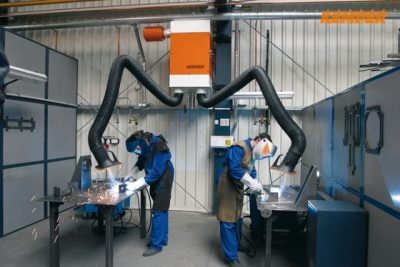At the beginning of 2019, the Health and Safety Executive (HSE) reported a rise in standards for welding fumes. The reason behind it is a report issued by the International Agency for Research on Cancer in 2017. It states that UV radiation from welding as well as welding fumes are considered as Group 1 carcinogens. The new standards declare that all indoor welding tasks need to be performed under local exhaust ventilation (LEV). In addition, if the LEV is unable to control the amount of welding fumes, the workers are required to use personal respiratory protective equipment (RPE), more commonly known as welding fume masks. If the tasks are performed outdoors, there is no need for LEV and only RPE is required.
In order to meet the latest welding fume extraction regulations, companies can do the following:
Order modern welding fume extractors and RPE.
If the hot work is done only outdoors, the simplest way to protect your welders and meet the requirements of the HSE is to provide each worker with personal respiratory protective equipment. If welding is performed indoors, you will need to acquire a professional welding fume extraction system to help regulate the fumes. Make sure to calculate the units that your business needs. Fortunately, since most extractors are mobile, they can be used by multiple workers. In addition, there are systems with two arms, designed to be used by two welders simultaneously.
Minimise the released amount of fumes.
One of the easiest ways to meet the latest standards is to simply lower the welding fumes your employees are exposed to. This can be done by using cold jointing instead of welding in some processes. Alternatively, you can benefit from modern 3D/CAD designs in order to produce more accurate items that require less hot work. Furthermore, companies are starting to use low-fume techniques that result in less welding fume exposure, such as submerged-arc welding as well as resistance welding. You can also reduce to a minimum the usage of the techniques with the highest fume output – arc gouging and flux core welding.
Maintain your exhaust ventilation in good condition.
The LEV on the manufacturing premises needs to be kept in proper condition in order to guarantee that welding fume hazards are kept to a minimum. The HSE recommends monthly checks for the most used equipment such as welding fume masks and visors, quarterly checks for less-used accessories and machinery, and thorough maintenance and examination of the local exhaust ventilation by a competent specialist.
The main factors you need to have in mind when preparing your company to meet the latest HSE regulations are the welding techniques used by the workers, what consumables are used for the hot work, and whether extraction systems are suitable in your particular case. If your welders can adopt techniques that will lower the amount of fume and extraction and that are a suitable option for your operations as well, meeting the standards will not be hard. For a large percentage of cutting and welding jobs, introducing an extraction and filtration system is not the optimal choice. In some cases, it might be better to benefit from air-fed RPE for the welders. Each case and each business model is different, so make sure to consult with an expert in order to know that you have the optimal equipment for your workers.
If you need professional equipment to meet the latest HSE welding fume regulations, have a look at the products offered by Ducting Express. Manufactured by reputable producers such as Nederman and Kemper, these welding fume extractors are ideal for small businesses as well as large industrial companies.
